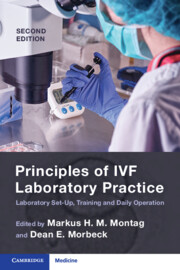Book contents
- Principles of IVF Laboratory Practice
- Principles of IVF Laboratory Practice
- Copyright page
- Contents
- Contributors
- Foreword
- The Evolution of IVF Practice
- Section 1 Starting a New Laboratory and Training Protocols
- Section 2 Pre-procedure Protocols
- Section 3 Gametes
- Chapter 14 Sperm Preparation for Therapeutic IVF
- Chapter 15 Processing Surgically Retrieved Sperm in the IVF Laboratory
- Chapter 16 Cryopreservation of Sperm for IVF
- Chapter 17 Oocyte Collection for IVF
- Chapter 18 In Vitro Maturation of Immature Oocytes for IVM–IVF
- Chapter 19 Oocyte Grading by Morphological Evaluation
- Chapter 20 Vitrification of Oocytes for IVF
- Section 4 Insemination/ICSI
- Section 5 Fertilization Assessment
- Section 6 Embryo Assessment: Morphology and Beyond
- Section 7 Embryo Cryopreservation
- Section 8 Embryo Transfer
- Section 9 Quality Management
- Index
- References
Chapter 16 - Cryopreservation of Sperm for IVF
Semen Samples and Individual Sperm
from Section 3 - Gametes
Published online by Cambridge University Press: 07 August 2023
- Principles of IVF Laboratory Practice
- Principles of IVF Laboratory Practice
- Copyright page
- Contents
- Contributors
- Foreword
- The Evolution of IVF Practice
- Section 1 Starting a New Laboratory and Training Protocols
- Section 2 Pre-procedure Protocols
- Section 3 Gametes
- Chapter 14 Sperm Preparation for Therapeutic IVF
- Chapter 15 Processing Surgically Retrieved Sperm in the IVF Laboratory
- Chapter 16 Cryopreservation of Sperm for IVF
- Chapter 17 Oocyte Collection for IVF
- Chapter 18 In Vitro Maturation of Immature Oocytes for IVM–IVF
- Chapter 19 Oocyte Grading by Morphological Evaluation
- Chapter 20 Vitrification of Oocytes for IVF
- Section 4 Insemination/ICSI
- Section 5 Fertilization Assessment
- Section 6 Embryo Assessment: Morphology and Beyond
- Section 7 Embryo Cryopreservation
- Section 8 Embryo Transfer
- Section 9 Quality Management
- Index
- References
Summary
Cryopreservation of human spermatozoa offers male patients the option to preserve fertility prior to initiating cancer therapy, vasectomy or assisted reproductive technology (ART) treatment. Human sperm can be easily cryopreserved in liquid nitrogen and stored for years. A number of cryopreservation techniques and cryoprotectants have been investigated. To date, however, vapour-phase or programmed slow cooling using a glycerol/egg yolk buffer cryoprotectant has been the most widely applied sperm cryopreservation protocol. Sperm cryosurvival rates of 40% to 60% are generally achievable. However, in patients having low motility or low sperm number at the outset, cryopreservation and recovery of viable sperm can be more challenging. In such cases, freezing of single sperm or small numbers of sperm is emerging as a valuable tool. With this technique, intracytoplasmic sperm injection (ICSI) can be performed even in cases with only a few frozen spermatozoa.
Keywords
- Type
- Chapter
- Information
- Principles of IVF Laboratory PracticeLaboratory Set-Up, Training and Daily Operation, pp. 121 - 129Publisher: Cambridge University PressPrint publication year: 2023



